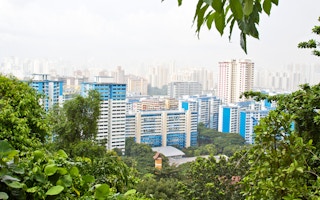Comparative city rankings such as the Economist Intelligence Unit’s Liveability Ranking and Overview and Mercer Quality of Living Survey often trigger a tizzy of excitement or glum introspection in cities, depending on how they have performed.
But when it comes to a city’s sustainable development, definitive rankings are “too broad-brushed to be useful for policy application,” say researchers from the Centre for Sustainable Asian Cities (CSAC), an interdisciplinary research group within the National University of Singapore (NUS).
Led by principal investigator Dr Malone-Lee Lai Choo, CSAC researchers have developed a different way of benchmarking sustainable development that does not involve rankings or indices, which Malone-Lee described as being plagued by “a lot of inherent problems, depending on the kinds of indicators assessed, weightage systems used, and the cities chosen for benchmarking”.
Speaking to about 100 guests at the CSAC’s inaugural research symposium at NUS on Thursday, Malone-Lee added that a comparative analysis of cities at different stages of development, and which had different environmental concerns and social and economic structures, is “not only unhelpful but often present distorted outcomes”.
She said this as she presented the CSAC’s project on Benchmarks, Best Practices and Framework for Sustainable Urban Development and Cities, which focuses on urban sustainability indicators, best practices, and governance principles.
The framework defines economic development, optimal use of land, water, energy and food resources, environmental protection, and community well-being as the four key pillars of sustainable urban growth.
Through a literature review of international urban development studies, existing assessment tools and global best practices, it identifies 13 sustainability issues that are applicable to all cities, and which can be used to assess a city’s performance.
These indicators, which were shortlisted after consultation with over 100 experts and government agencies, include: governance, economy, land, water, energy, food, biodiversity, air, waste, transport, culture, community, and climate change.
The framework also presents a database of best practices in urban sustainability relating to each of the 13 themes, which can serve as lessons and inspiration for other cities, she said. These include, for example, Copenhagen’s success at encouraging non-motorised transport, Singapore’s public housing infrastructure, and Stockholm’s air quality management practices.
Due to the open-ended nature of this framework, cities at differing stages of development could prioritise different aspects of sustainable development, and assess their performance against others, said Malone-Lee, who is also the centre’s director.
They could also use it to compare their performance against global standards such as the World Health Organisation guidelines on air and water quality, she added.
She noted that this would help cities assess their own level of sustainable development and set higher targets to transit to more sustainable growth at their own pace.
“
We also need to integrate more greenery into the built environment and allow more biodiversity to flourish, and design for a pleasant living environment with natural light and ventilation, aural and thermal comfort.
Desmond Lee, Minister of State for National Development
Desmond Lee, Singapore’s Minister of State for National Development, who was the event’s guest of honour, said that this framework “provided a way to understand Singapore’s progress in relation to other cities,” and added that it helped ensure that urban planning efforts met sustainable development goals.
Lee added that Singapore’s urban landscape with its closely packed residential and office buildings and high population densities posed a challenge to achieving a high quality of life for residents. Creating a liveable and sustainable Singapore would involve enhancing connectivity and access to services and amenities for residents, he added.
“We also need to integrate more greenery into the built environment and allow more biodiversity to flourish, and design for a pleasant living environment with natural light and ventilation, aural and thermal comfort,” he said.
Projects that worked towards these objectives were also showcased at the symposium, with many of them being supported by the Ministry of National Development’s (MND) research fund for the built environment, which set aside S$50 million for urban sustainability initiatives.
For example, CSAC researcher Wong Nyuk Hien showcased an urban planning tool that could help planners mitigate the unusually high temperatures associated with densely built up urban environments.
Using Singapore neighbourhoods such as Punggol, Marina Bay, and one-north, Wong showed that land use planning and building design that factored in environmental factors such as natural ventilation and the shade provided by trees could maximise comfort while reducing energy use.
CSAC researchers Hugh Tan and Chong Kwek Yan also presented findings from a study that explored how natural and man-made greenery could be managed for biodiversity to thrive in Singapore. The study found that man-made greenery was not an adequate substitute for natural, untouched greenery, which provided more effective shelter for animals and birds.
The study advocated for the development of “semi-natural” spaces in which trees and plants were left wild after being planted by park authorities, and taking special care to retain large trees during development.
Lee shared that the next 10 to 15 years would bring new opportunities for more urban sustainability projects to be researched, tested, and deployed in Singapore.
“We will be building up existing towns and opening up new growth areas, such as Bidadari, Punggol, Northshore, Jurong Lake District, and the Greater Southern Waterfront,” said Lee. “The opening of these new areas will create opportunities for experimentation, test-bedding and deploying research solutions.”
Lee also shared that this research would receive continued support from the MND Research Fund, and the National Research Foundation’s S$135 million Land and Liveability National Innovation Challenge, which supports the research and development of technologies that will maximise the cost effectiveness and efficiency of land use in Singapore.
“Through closer engagement with the research community in years to come, we can find innovative ways to create a liveable and sustainable home,” he said.

















